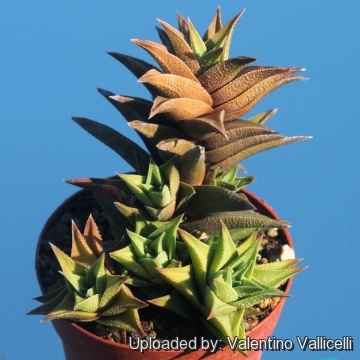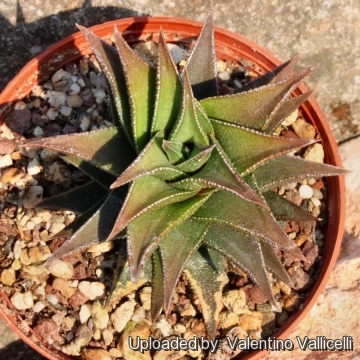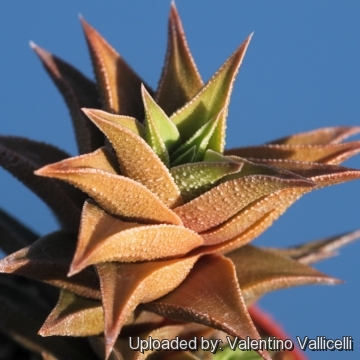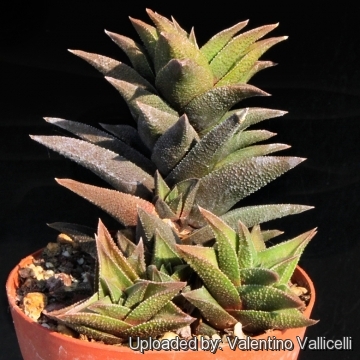Donate now to support the LLIFLE projects.
Your support is critical to our success.
Your support is critical to our success.
= Haworthia tortuosa var. pseudorigida (Salm-Dyck) A.Berger
Pflanzenr. (Engler) IV, 38: 79 1908
Accepted Scientific Name: Haworthia viscosa (L.) Haw.
Syn. Pl. Succ. 90 1812

Aloe pseudorigida (Haworthia tortuosa var. pseudorigida) Photo by: Valentino Vallicelli
Synonyms:
- Haworthia tortuosa var. pseudorigida (Salm-Dyck) A.Berger
- Aloe pseudorigida Salm-Dyck
- Apicra pseudorigida (Salm-Dyck) Haw.
- Haworthia pseudorigida Haw.
See all synonyms of Haworthia viscosa
back
Accepted name in llifle Database:Haworthia viscosa (L.) Haw.
Syn. Pl. Succ. 90 1812
Synonymy: 67
- Haworthia viscosa (L.) Haw.
- Aloe viscosa L.
- Apicra viscosa (L.) Willd.
- Catevala viscosa (L.) Kuntze
- Tulista viscosa (L.) G.D.Rowley
- Haworthia asperiuscula var. patagiata G.G.Sm.
- Haworthia asperiuscula var. subintegra G.G.Sm.
- Haworthia beanii var. minor G.G.Sm.
- Haworthia cordifolia Haw.
- Aloe cordifolia (Haw.) Schult. & Schult.f.
- Catevala cordifolia (Haw.) Kuntze
- Haworthia rigida (Willd. non Lamarck)
- Aloe rigida (Willd.) Jacq.
- Apicra rigida Willd.
- Haworthia subrigida (Schult. & Schult.f.) Baker
- Aloe subrigida Schult. & Schult.f.
- Catevala subrigida (Schult. & Schult.f.) Kuntze
- Haworthia subtortuosa (Schult. & Schult.f.) Sweet
- Aloe subtortuosa Schult. & Schult.f.
- Haworthia tortuosa (Haw.) Haw.
- Aloe tortuosa Haw.
- Apicra tortuosa (Haw.) Willd.
- Catevala tortuosa Kuntze
- Haworthia tortuosa var. curta (Haw.) Baker
- Haworthia curta Haw.
- Haworthia tortuosa var. major (Salm-Dyck) A.Berger
- Aloe tortuosa var. major Salm-Dyck
- Haworthia tortuosa var. pseudorigida (Salm-Dyck) A.Berger
- Aloe pseudorigida Salm-Dyck
- Apicra pseudorigida (Salm-Dyck) Haw.
- Haworthia pseudorigida Haw.
- Haworthia tortuosa var. tortella (Haw.) Baker
- Haworthia tortella Haw.
- Haworthia tortuosa f. variegata hort.
- Haworthia triangularis (Lamarck)
- Aloe triangularis Lamarck
- Haworthia viscosa f. asperiuscula (Haw.) Pilbeam
- Aloe asperiuscula (Haw.) Schult. & Schult.f.
- Catevala asperiuscula (Haw.) Kuntze
- Haworthia asperiuscula Haw.
- Haworthia viscosa f. beanii (G.G.Sm.) Pilbeam
- Haworthia beanii G.G.Sm.
- Haworthia viscosa var. caespitosa Poelln.
- Haworthia viscosa var. concinna (Haw.) Baker
- Aloe concinna (Haw.) Schult. & Schult.f.
- Haworthia concinna Haw.
- Haworthia viscosa var. cougaensis G.G.Sm.
- Haworthia viscosa subs. derekii-clarkii Halda
- Haworthia viscosa var. indurata (Haw.) Baker
- Aloe indurata (Haw.) Schult. & Schult.f.
- Aloe viscosa var. indurata (Haw.) Salm-Dyck
- Haworthia indurata Haw.
- Haworthia viscosa var. major Haw.
- Haworthia viscosa var. minor Haw.
- Haworthia viscosa var. parvifolia Haw.
- Haworthia viscosa var. pseudotortuosa (Salm-Dyck) Baker
- Aloe pseudotortuosa Salm-Dyck
- Haworthia pseudotortuosa (Salm-Dyck) Haw.
- Haworthia viscosa f. pseudotortuosa (Salm-Dyck) Pilbeam
- Haworthia viscosa var. quaggaensis G.G.Sm.
- Haworthia viscosa var. subobtusa Poelln.
- Haworthia viscosa f. subobtusa (Poelln.) Pilbeam
- Haworthia viscosa var. torquata (Haw.) Baker
- Aloe torquata (Haw.) Schult. & Schult.f.
- Haworthia torquata Haw.
- Haworthia viscosa f. torquata (Haw.) Pilbeam
- Haworthia viscosa var. viridissima G.G.Sm.
Haworthia viscosa var. variabilis Breuer
Avonia 21(3): 61-62; figs. 2003 [15 Nov. 2003]
Synonymy: 3
- Haworthia viscosa var. variabilis Breuer
- Haworthia variabilis (Breuer) Breuer
- Haworthiopsis variabilis (Breuer) Zonn.
back

Aloe pseudorigida (Haworthia tortuosa var. pseudorigida) Photo by: Valentino Vallicelli

Aloe pseudorigida (Haworthia tortuosa var. pseudorigida) Photo by: Valentino Vallicelli

Aloe pseudorigida (Haworthia tortuosa var. pseudorigida) Photo by: Valentino Vallicelli

Aloe pseudorigida (Haworthia tortuosa var. pseudorigida) Photo by: Valentino Vallicelli
| Your Actions | |
|---|---|
| Back to Aloe index | |
| Back to Aloaceae index | |
 |
Back to Succulents Encyclopedia index |








